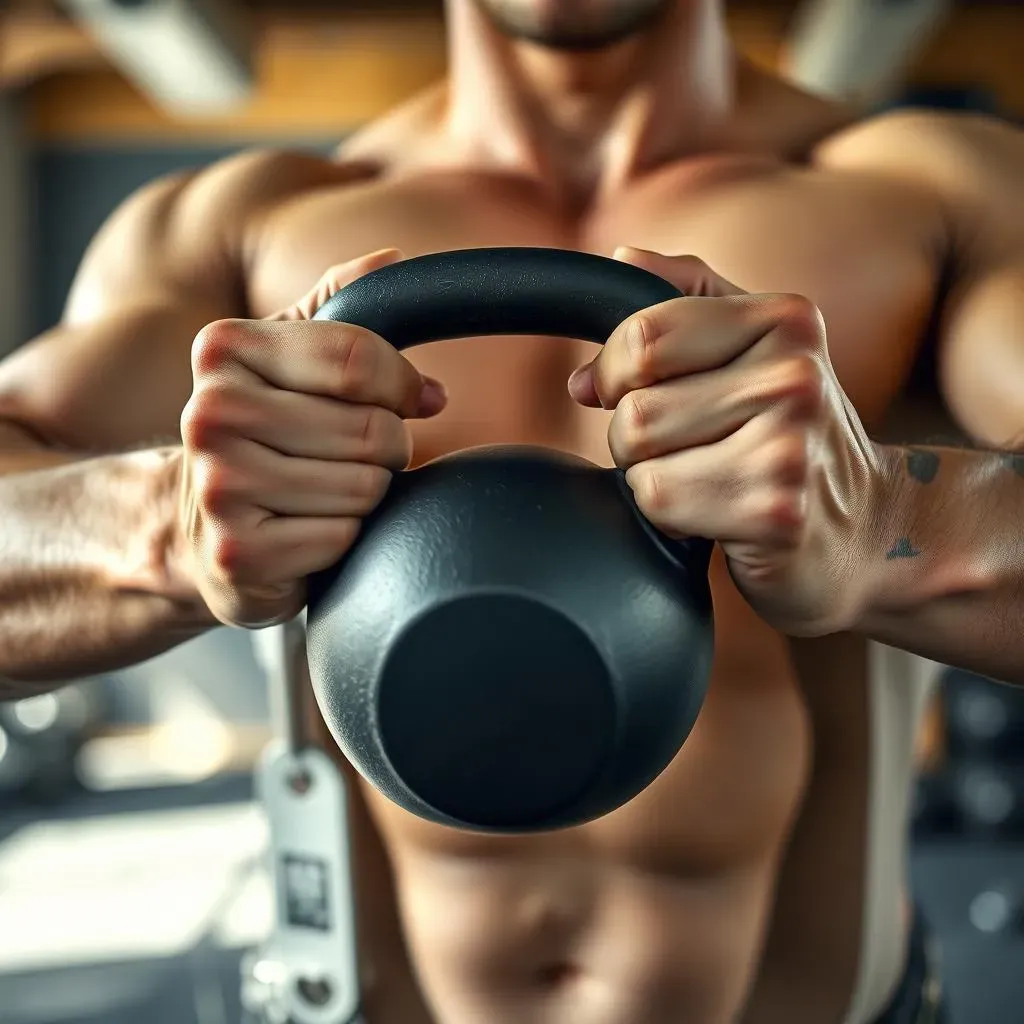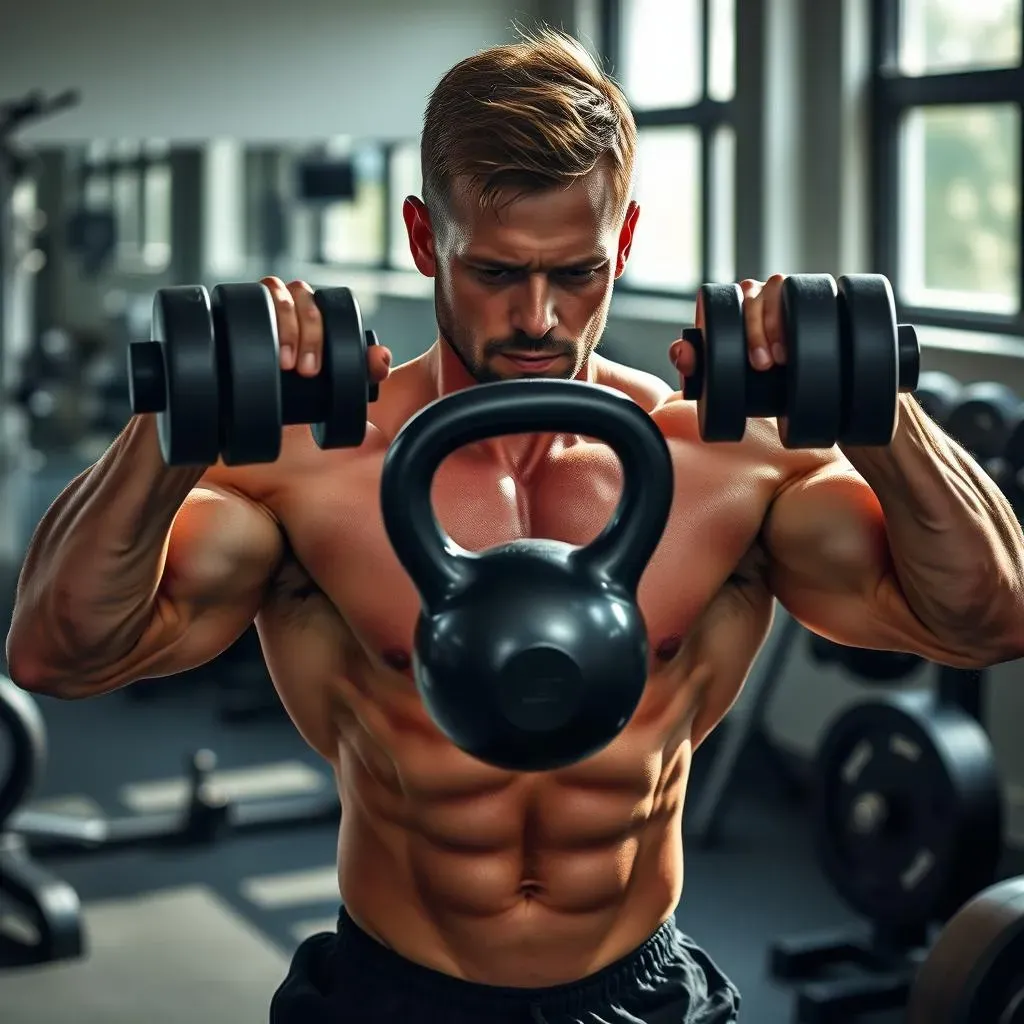Table of Contents
Ready to ditch the boring bench press and try something new for your chest day? Let's talk about the "chest kettlebell workout." You might be thinking, "Kettlebells? For my chest?" Absolutely! These cannonball-shaped weights aren't just for swings and squats; they're fantastic for building a strong, defined chest. We're not talking about some trendy fitness fad here; kettlebells offer unique advantages that can help you break through plateaus and achieve serious muscle gains. This article will guide you through why kettlebells are so effective for chest training, and we'll cover five killer exercises that'll have your pecs screaming. Plus, I'll share some essential tips to make sure you're getting the most out of every rep. So, if you're looking to add some serious punch to your chest workouts, keep reading. Let's get started with this "chest kettlebell workout" journey!
Why Kettlebells Are Great for Chest Workouts

Why Kettlebells Are Great for Chest Workouts
so you're probably used to barbells and dumbbells for your chest workouts, right? But let me tell you, kettlebells bring a whole new dimension to the game. It's not just about lifting heavy; it's about how you lift. Kettlebells have this unique off-center weight thing going on, which forces your muscles to work harder to stabilize the load, especially during chest exercises. This means you're not just working your pecs, but also your shoulders, triceps, and even your core. It's like a full-body party, but the chest is definitely the guest of honor. I find that this extra stabilization work can really help with overall strength and coordination.
Top 5 Chest Exercises with Kettlebells

Top 5 Chest Exercises with Kettlebells
Kettlebell Floor Press
Alright, let's get into the good stuff. First up is the kettlebell floor press. Think of it as a dumbbell floor press’s cooler cousin. You're lying on your back, knees bent, feet flat on the floor, and instead of a dumbbell, you've got a kettlebell in each hand. The key is to keep your elbows tucked in at about a 45-degree angle as you lower the weight. This not only protects your shoulders but also puts more emphasis on your chest. I love this exercise because it really lets you focus on squeezing the pecs at the top of the movement. Plus, it's a great way to build strength without needing a bench.
It's also easier on your shoulders than a regular bench press. You're not pushing your elbows out wide, and the floor gives you a natural stop point, so you don't have to worry about overextending. I remember when I first started, I was surprised how much I could feel it in my chest. It's a humble exercise, but it packs a punch. Start with a weight you can control and focus on the form; the gains will follow.
Kettlebell Bench Press
Next, we have the kettlebell bench press. Now, this one's a classic, but with a kettlebell twist. You’ll need a bench or a stable surface, and you'll be holding the kettlebells with a neutral grip, meaning your palms are facing each other. As you press the kettlebells up, make sure you don't let them wobble all over the place. The beauty of using kettlebells here is that they challenge your stability more than dumbbells, which means your chest muscles have to work harder to keep everything steady. It’s like they are dancing, but you want to control the dance, not the other way around.
I find that this variation works the middle part of my chest really well. It’s also a good way to see if there are any strength imbalances in your arms. You might notice that one side feels a little stronger, and that's okay. Just focus on keeping your form consistent on both sides. This is a great exercise for building size and strength.
Exercise | Sets | Reps | Focus |
|---|---|---|---|
Kettlebell Floor Press | 3-4 | 8-12 | Pecs, Triceps, Stability |
Kettlebell Bench Press | 3-4 | 8-12 | Pecs, Shoulders, Stability |
Incline Kettlebell Press
Time to hit the upper chest with incline kettlebell presses. Grab an adjustable bench and set it to about a 30-45 degree angle. The incline will target the upper portion of your pecs, giving your chest that nice, full look. It's the same idea as the flat bench press, but now you are working at an angle. The kettlebells will be a little more challenging to control, but that's a good thing. It forces the smaller muscles in your shoulder and chest to work overtime.
I like this exercise because it helps to shape and define the upper chest, which is often neglected. Make sure you are keeping your elbows tucked and your core engaged to prevent any lower back issues. If you are new to this, start with a lighter weight and focus on getting the movement right.
Kettlebell Flyes
Next up, kettlebell flyes. This exercise is a bit more tricky, so take it slow. Lie flat on your back on a bench. Hold a kettlebell in each hand with your palms facing each other, and slightly bend your elbows. Lower the kettlebells out to the sides, keeping that slight bend in your elbows, until you feel a stretch in your chest. Then, bring them back up. The key is to keep the movement controlled and not let the kettlebells drop down. I cannot stress enough how important it is to control the weight. You want to feel the stretch in your chest.
This exercise is great for really isolating the chest muscles. It's not about lifting heavy, but about feeling the muscle contract and stretch. If you find it hard to balance, you can start by doing this on the floor, it will give you more stability. Start with very light weight, the focus is not about weight but how well you can isolate the chest muscles.
Exercise | Sets | Reps | Focus |
|---|---|---|---|
Incline Kettlebell Press | 3-4 | 8-12 | Upper Pecs, Shoulders |
Kettlebell Flyes | 3-4 | 10-15 | Pecs, Stability |
Deficit Push-Ups with Kettlebells
Last but not least, let's talk about deficit push-ups using kettlebells. Place two kettlebells on the floor, shoulder-width apart. Get into a push-up position with your hands on the kettlebell handles. As you lower yourself down, your chest will go lower than your hands, which gives you a deeper stretch and more muscle activation. It is a great way to increase the range of motion during a push up. This will make it more challenging and effective.
I like this variation because it hits the lower pecs and triceps really well. If you find it too hard at first, you can start by doing push-ups with your hands on the kettlebells without going into a deficit. And you can always start with knee push-ups. As you get stronger, you can increase the depth and the number of reps.
These five exercises are a solid starting point for building a stronger chest using kettlebells. They offer a great mix of strength, stability, and muscle activation. Remember to focus on form over weight, especially when you're just starting out. And most importantly, have fun with it!
Exercise | Sets | Reps | Focus |
|---|---|---|---|
Deficit Push-Ups with Kettlebells | 3-4 | As many as possible | Lower Pecs, Triceps |
Tips for Effective Kettlebell Chest Training

Tips for Effective Kettlebell Chest Training
Grip and Hand Insertion
Alright, let’s talk about the nitty-gritty: your grip and how you hold those kettlebells. It's not as simple as just grabbing and lifting. The way you insert your hand into the kettlebell can make a big difference in how you perform your exercises. You want the kettlebell to sit comfortably in the heel of your hand, not too high up by your fingers. This gives you more control and helps to prevent wrist strain. It's almost like you are gently cradling the kettlebell.
A good grip is key for safety and effectiveness. If you’re gripping the kettlebell too hard, you’ll fatigue faster and may not get the full benefit of the exercise. A relaxed grip, but with control, will allow you to focus on your chest muscles. So, before you start any exercise, take a moment to ensure your grip is correct. It's a small detail, but it makes a world of difference.
Progressive Overload and Double Progression
Now, let's chat about how to actually make gains. You can't just keep lifting the same weight and expect to see changes, right? That's where progressive overload comes in. It means gradually increasing the demand on your muscles over time. You can do this by adding more weight, reps, or sets. If you are stuck, don't worry it happens. That's why double progression is great, it means you can also increase your reps before adding more weight.
For example, if you can do 10 reps of the kettlebell floor press with 20 pounds, try to do 12 reps next time before you add more weight. Then, once you can do 12 reps comfortably, try increasing the weight to 25 pounds and start again with 8 reps. This way, you're always pushing your muscles a little bit further, which leads to growth and strength gains. Remember, consistency is key. You don't have to do everything at once, small changes over time are what matters. It is a marathon not a sprint.
Tip | Description |
|---|---|
Proper Grip | Hold the kettlebell in the heel of your hand for better control. |
Progressive Overload | Gradually increase weight, reps, or sets over time. |
Double Progression | Increase reps before adding weight. |
Wrapping Up Your Chest Kettlebell Workout
So, there you have it – a solid starting point for building a powerful chest with kettlebells. We’ve covered why they're awesome, five key exercises to get you going, and some critical tips to keep you safe and progressing. Remember, consistency is the real magic, and it’s okay to start slow and build up. Don't be afraid to experiment with variations and find what works best for your body. The key is to stay curious, challenge yourself, and most importantly, have fun with it. Now, go grab those kettlebells and get after it! Your chest will thank you later.